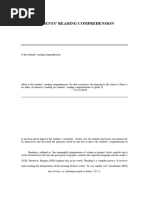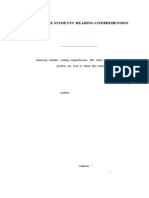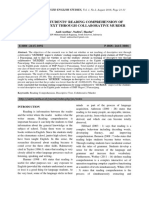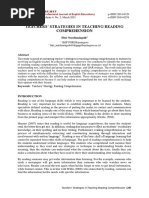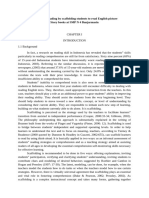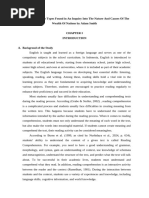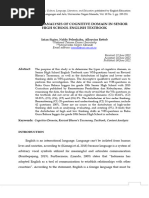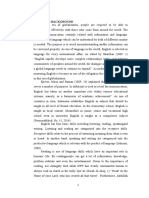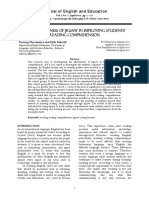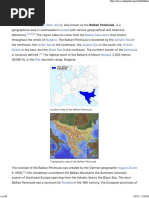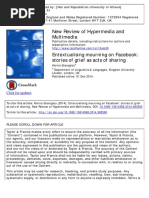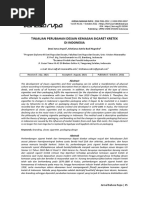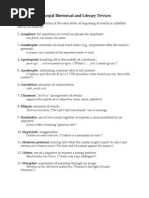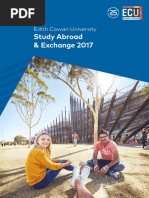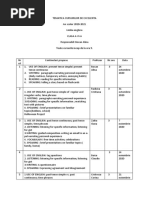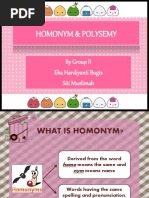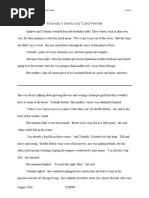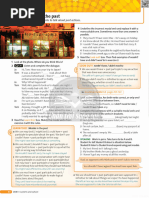4874-12881-1-PB
4874-12881-1-PB
Uploaded by
Hidayati RohmahCopyright:
Available Formats
4874-12881-1-PB
4874-12881-1-PB
Uploaded by
Hidayati RohmahCopyright
Available Formats
Share this document
Did you find this document useful?
Is this content inappropriate?
Copyright:
Available Formats
4874-12881-1-PB
4874-12881-1-PB
Uploaded by
Hidayati RohmahCopyright:
Available Formats
Jurnal Bilingual p-ISSN.
2088-2858
e-ISSN. 2774-9681
STUDENTS’ READING COMPREHENSION IN READING ENGLISH TEXTBOOK
Jusman A. Sahmal 1, Sutaryo2, Naniek Jusnita3, Suratman Dahlan4
1, 2, 3, 4
English Language Education Study Program, University of Khairun, Ternate, Indonesia
Corresponding author: suratmandahlan@unkhair.ac.id
Abstrak
Tujuan penelitian ini adalah untuk mengetahui pemahaman membaca siswa dalam membaca buku teks bahasa
Inggris salah satu Universitas di Indonesia. Penelitian ini menggunakan metode kualitatif dengan analisis
statistik deskriptif. Sampel penelitian terdiri dari 30 mahasiswa. Instrumen yang digunakan adalah tes
pemahaman bacaan untuk mengumpulkan data. Data dianalisis dengan menginterpretasikan hasil tes
pemahaman bacaan. Hasil penelitian menunjukkan bahwa skor pemahaman bacaan dalam membaca buku teks
bahasa Inggris termasuk dalam kategori buruk dengan rata-rata (24,63). Skor tertinggi pemahaman membaca
siswa adalah buruk (53) dan skor terendah juga buruk (7). Kemampuan mereka dalam Literal (L), Inferential
(F), dan Critical Creative (K) juga umumnya buruk.
Kata Kunci: Pemahaman Membaca, Buku teks bahasa Inggris
Abstract
This research objective is to find out the students’ reading comprehension in reading English textbook in one of
State Universities in Indonesia. This research used qualitative method with descriptive statistical analysis. The
sample of the research consisted of 30 students. The instrument was reading comprehension test to collect the
data. The data were analyzed by interpreting the result of reading comprehension test. The result of this research
shows that the score of reading comprehension in reading English textbook were categorized as poor with the
average of (24.63). The highest score of students’ reading comprehension was poor (53) and the lowest score
was also poor (7). Their abilities in Literal (L), Inferential (F), and Critical Creative (K) are also generally poor.
Keywords: reading comprehension, English textbook
INTRODUCTION
Reading is one of the four language skills taught in English language learning process besides
listening, speaking and writing. However, among of all the skills reading is considered as the most
important skill. According to Kartawijaya (2017), reading is known as the language skill that very
important in teaching and learning English. It is the process of getting information from something
that was written, to obtain information and to improve the science and knowledge. In this case, Fitri &
Rozimela (2020) said that the study about students’ reading comprehension is important since it is an
important language skill in Indonesian curriculum.
Therefore it becomes one of the language skills that needed to be mastered by students.
Reading skill give much benefit to students such as increasing personal confidence, reducing social
isolation, fostering a sense of community and encouraging communication skills. Through reading,
students could improve their vocabulary, get new information and learn many things. Reading is a
process of gaining a message which is convey by a writer through words or written language. When
reading, eyes are going to recognize every word meanwhile brain try to analyze and link to the
meaning of the writing.
Textbook is a book which is designed to give material, assessment and evaluation for the
students. It also shapes the process of teaching learning in the class that provides the primary form of
linguistic input. It is very influential in changing students 'mindsets because they can affect students'
knowledge and specific value. It also becomes the main resources in education learning to get
standard competence and the main competence, which means that it has significance role in
Indonesian objective curriculum. In Indonesian’s curriculum textbook has an important role in
teaching and learning process. It is also mentioned in the Indonesian government regulation number
Vol. 12 No.1 MEI 2022 57
Jurnal Bilingual p-ISSN. 2088-2858
e-ISSN. 2774-9681
32 in 2013 article 1 section 23 as, stated: “Buku teks pelajaran adalah sumber pembelajaran utama
untuk mencapai kompetensi dasar dan kompetensi inti”. Thus, in order to support English language
teaching, the design materials in a textbook must be appropriate with learning objectives.
English textbooks had been used by the students when they were in high school. However,
Abanda’s (2016) result of his study proved that English Education Study Program of the 3rd semester
students have the average score in reading comprehension of items 1-29 is poor (32) even the average
score in items 30-45 is very poor (25,56). Therefore, the researchers deeply analyzed the students
comprehend English textbook.
Reading Comprehension
Reading is one of language skills that students should know. The readers do reading to get
information and knowledge from a text,. While reading comprehension is an important skill needed
for all areas of school. Subjects, other than reading or literature, where comprehension skills are
significantly important include science, social studies and math (Misra, Jusnita, Ali, & Dahlan
(2021).
According to Klingner, et al (2007), reading comprehension as a complex process to get
meaning from the author including word meaning, word knowledge, and fluency. It refers to the
ability in interpreting the words, understanding the meaning and the relationships between ideas
conveyed in a text. He also added reading comprehension is not only the reader response to the
author’s meaning but multi complex process to involve many interactions between the reader and
what they comprehend from the text. Is not only to understand the text or reading passage but also to
interpret, to problem-solve, to visualize, hypothesizing, to observe, to report, to organize data, to
follow directions, to draw conclusion, and to predict outcomes based on the text.
While, according to Sung, Chang & Huang (2008), for enhancing reading ability, one of the
methods most often recommended by researchers is reading strategy instruction. But this research
focus on students’ reading comprehension in reading English textbook.
Defining the Reading Comprehension Levels
Dagostino, Carifio, Bauer, Zhao, & Hashim (2014) stated that the reading comprehension levels
and the reading skills determine the difficulty and the nature of the reading texts and the test items.
a. Literal (Message extraction)
Literal Reading Comprehension, which refers to the memorization of facts in texts where
information is explicitly stated at a basic level of thinking.
b. Inferential (Message Interpretation)
Inferential Reading Comprehension, which refers to the ability of students to interpret meaning
where they need to use overt information along with intuition, reasoning, and experience to attain
the higher level of thinking assessed, and
c. Critical/Creative (Message Evaluation)
Critical/creative Reading Comprehension, which refers to the student’s ability to do an overall
critical evaluation of certain information or an idea that has been read in terms of the precision
and/or suitability of the given information of a new idea, encountered. This critical evaluation
may require some divergent thinking and depend to some degree upon the knowledge and
personal experience of the student, but it focuses mostly on convergent critical thinking being
done by the student.
In summary, reading comprehension strategy is a way which will help students to read and
understand what have they read. Students will start to set their goals before read a text, keep on
Vol. 12 No.1 MEI 2022 58
Jurnal Bilingual p-ISSN. 2088-2858
e-ISSN. 2774-9681
reading text, then at the end students are ask to focus on showing their understanding of reading the
text.
English Textbook
A textbook is a book used for the study of a subject. People use a textbook to learn facts and
methods about a certain subject. According to Bojanić & Topalov (2016), textbooks are undoubtedly
the most popular teaching materials used in foreign language classes. Therefore, it is highly
significant that textbooks include the essential elements of language and culture and that they
correspond to learners’ needs, cultural background and level of linguistic proficiency.
Textbooks sometimes have questions to test the knowledge and understanding of the learner. A
workbook is a type of textbook that has only practice questions and exercises. Workbooks are
designed not to teach but to provide practice and to highlight areas which need more learning. A
revision guide is a type of textbook that is used to remind the learner about the subject and give
him/her extra practice, especially before an examination. According Sulistiyana (2020), a textbook is
a media as source of material in teaching learning, which is based on the curriculum used in current
by single writer or a group of writers and used in schools. Then, an English textbook is primary
resource to teach English in classroom.
A Textbook is defined as “a book that teaches a particular subject and that is used especially in
schools and colleges” Textbooks usually combine contemporary and traditional approaches to
language teaching. They incorporate concepts such as ‘learner development’, a ‘task-based
methodology’, and ‘cross-curricular themes’ while providing a grammar framework and a thorough
practice of vocabulary, grammatical structures and functions (Hutchinson & Gault, 2009; Bojanić &
Topalov, 2016).
Cunningsworth (cited in Sulistiyana, 2020) claims that “no course book will be totally suited to
a particular teaching situation. The teacher will have to find his own way of using it and adapting it if
necessary. That is why, we should not be looking for the perfect course book which meets all our
requirements, but rather for the best possible fit between what the course book offers and what we as
teachers and our students need”.
RESEARCH METHOD
This research applied qualitative method with descriptive statistic analysis which describes
research problem through a description. The method is to gather information about research variable
that is students’ reading comprehension in reading English textbook.
This research was conducted at one of the state Universities in Indonesia. This research
involves 30 students of the fifth semester as the subjects of the research and are taken purposively. In
particularly, the researcher is going to involve the subjects who have passed all reading courses at
English Education Study Program and they are more active in the class based on the observation.
To collect the data, the students were asked to do the test, which dealt with the students’
reading comprehension in reading English textbook. The test consisted of 15 questions; each question
contained one reading skill analysis. The test was multiple choices/objective, based on the indicators
of reading comprehension from English textbook. The length of time to do the test is approximately
30 minutes. The constructs of the test included the passage taken from English textbook. The
assessment of a reading comprehension instrument refers to cognitive abilities as defined by Bloom’s
revised taxonomy (cited in Abbas, 2016).
After collecting the data, the researcher counted the number of correct answers, then concluded
the total score from the result of the test. Each student’s scores were calculated by using the
following formula:
Vol. 12 No.1 MEI 2022 59
Jurnal Bilingual p-ISSN. 2088-2858
e-ISSN. 2774-9681
𝑋
M = 𝑁 × 100
Where:
M = Individual score
X = The number of correct answer
N = The number of item (Wayan and Sumartana, 1986)
In order to find out the categories of scores, the following are classification of the score.
Table 1. Score Categories
No Scores Categories
1 90 – 100 Very good
2 80 – 89 Good
3 70 – 79 Sufficient
4 <70 Poor
FINDING AND DISCUSSION
Finding
The data of students’ reading comprehension test scores with the classifications are as follows;
in the test four students (13.3%) obtained 7 score, five students (16.67%) obtained 13 score, six
students (20%) obtained 27 score, four students (13.3%) obtained 20 score, seven students (23.3%)
obtained 33 score, three students (10%) obtained 40, and one student (3%) obtained 53 score. All
scores were categories less.
The data of students’ reading comprehension in reading English Textbook test based on the
category are as follows; in terms of Literal (L) Reading comprehension Category, there were six
questions of the test. As the result, more than 20% of the respondents were able to obtain 2 correct
numbers of the test (Nine students or 30%), Eight students or (26.67%) obtained 3 correct numbers of
the test, and Seven students or (23.33%) obtained 1 correct number of the test. More than 10% of the
respondents did not obtain any correct numbers of the test (Five students or 16.67%). Below than 5%
of the respondents were able to obtain 4 correct numbers of the test (One student or 3.33%) and no
students obtain 5 and 6 correct numbers of the test.
In terms of Inferential (F) Reading Comprehension Category, there were five questions of the
test. As the result, more than 30% of the respondents obtained 1 correct number of the test (10
students or 33.33%) and Nine students or (30%) did not obtain any correct numbers of the test. More
than 20% of the respondents obtained 2 correct numbers of the test (Seven students or 23.33%).
Below 15% of the respondents obtained 3 correct numbers of the test (Four students or 13.33%), and
no students obtained 4 and 5 correct numbers of the test.
In terms of Critical Creative (K) Reading Comprehension Category, there were four questions
of the test. As the result, there were 15 students or (50%) of the respondents did not obtain any correct
numbers of the test. Nine students or (30%) of the respondents obtained 1 correct number of the test.
More than 15% of the respondents obtained 2 correct number of the test (Five students or 16.67%).
Below that 5% of the respondents obtained 3 correct numbers of the test (1 student or 3.33%), and no
students obtained 4 correct numbers of the test.
In terms of Literal Category of reading comprehension, more than 30% of the respondents were
able to identify main idea (14 students or 47%), to make comparison (14 students or 47%), and to
identify the meaning of word/ phrase/ sentence (10 students or 33%). More than 20% of the
respondents were able to identify the important point (Seven students or 23%) and to identify the
Vol. 12 No.1 MEI 2022 60
Jurnal Bilingual p-ISSN. 2088-2858
e-ISSN. 2774-9681
cause-effect (Six students or 20%). Then, below 10% of the respondents were able to identify the
sequence of ideas/events (Two students or 7%).
In terms of Inferential Category of reading comprehension, more than 30% of the respondents
were able to interpret the cause-effect (10 students or 33%). More than 20% of the respondents were
able to interpret the comparison (Eight students or 27%), to make conclusion (Eight students or 27%),
and to interpret the important point (Seven students or 23%). Below 20% of the respondents were able
to interpret the main idea (Three students or 10%).
In terms of Critical Creative Category of reading comprehension, more than 20% of the
respondents were able to do evaluation of the reading passage (Seven students or 23%) and to do
internalize of the reading passage (Six students or 20%). Below 20% of the respondents were able to
draw conclusion (Four students or 13%) and to identify the moral of the lesson/story (Four students or
13%).
Based on the findings, it can be concluded that 30 students’ reading comprehension test result
were categorized as poor. Referring to the categories of scores, below 70 is categorized as poor.
Meanwhile, the highest score of the students was 53 and the lowest score was 7. This suggests that the
students had poor ability in reading comprehension in reading English textbook.
Discussion
The calculated result of this research revealed that students’ reading comprehension in reading
English textbook was poor. The result of this research is in line with Abanda (2016) and Kartawijaya
(2016) who found that students’ reading comprehension score were low or poor. According to
Klingner, et al (2007), reading comprehension as a complex process to get meaning from the author
including word meaning, word knowledge, and fluency. It refers to the ability in interpreting the
words, understanding the meaning and the relationships between ideas conveyed in a text. He also
added reading comprehension is not only the reader response to the author’s meaning but multi-
complex process to involve many interactions between the reader and what they comprehend from the
text.
All the questions obtained from the textbook entitled “Reading Comprehension Startegies;
Theories, Interventions, and Technology”. Where textbook is defined as “a book that teaches a
particular subject and that is used especially in schools and colleges.
The teacher will have to find his own way of using it and adapting it if necessary. So we should
not be looking for the perfect course book which meets all our requirements, but rather for the best
possible fit between what the course book offers and what we as teachers and our students need”. To
sum up, reading comprehension textbook is not totally suited to all students in reading comprehension
subject, however if the teacher’s way of teaching is suitable to the students’ necessary then it will
possible fit to them.
CONCLUSION
It was found that students involved in this research score of reading comprehension in reading
English textbook at the English Language Education Study Program were categorized as poor with
the average of (24.63). The highest score of students’ reading comprehension was poor (53) and the
lowest score was also poor (7). Their abilities in Literal (L), Inferential (F), and Critical Creative (K)
are also generally poor. The teacher will have to find his own way of using it and adapting it if
necessary. So we should not be looking for the perfect course book which meets all our requirements,
but rather for the best possible fit between what the course book offers and what we as teachers and
our students need”. To sum up, reading comprehension textbook is not totally suited to all students in
Vol. 12 No.1 MEI 2022 61
Jurnal Bilingual p-ISSN. 2088-2858
e-ISSN. 2774-9681
reading comprehension subject, however if the teacher’s way of teaching is suitable to the students’
necessary.
REFERENCES
Abanda, Basra. 2016. Students’Reading Comprehension at English Language Education Study
Program of Faculty of Teacher Training and Education of Khairun University. Ternate:
Universitas Khairun.
Abbas, PourhoseinGilakjani. 2016. How Can Students’ Improve Their Reading Comprehension Skill?
Journal of Studies in Education. 2: 230-235.DOI: Full Text: DOI:
https://doi.org/10.5296/jse.v6i2.9201.
Bimmel, Peter E. et.al. 2001. Effects of Strategy Training on Reading Comprehension in First and
Foreign Language. European Journal of Psychology of Education. 16: 509-529.
Bojanić, B. B. R., & Topalov, J. P. 2016. Textbooks in the EFL classroom: Defining, assessing and
analyzing. Зборник радова Филозофског факултета у Приштини, 46(3). DOI:
https://doi.org/10.5937/zrffp46-12094
Creswell, John W. Third Edition Research Design Qualitative, Quantitative, and Mixed Methods
Approaches. USA: SAGE Publications.
Fahim, Mansoor. et.al. 2010. Effect of Critical Thinking Strategy Training on Male/Female EFL
Learners’ Reading Comprehension. English Language Teaching. 5: 1-12.
Fitri, F., & Rozimela, Y. 2020. An analysis of students’ reading comprehension of analytical
exposition text in SMA Negeri 2 Batusangkar. Journal of English Language Teaching, 9(2),
405-415 DOI; https://doi.org/10.24036/jelt.v9i2.108613.
Dagostino, L., Carifio, J., Bauer, J. D., Zhao, Q., & Hashim, N. H. 2014. Assessment of a reading
comprehension instrument as it relates to cognitive abilities as defined by Bloom's revised
taxonomy. Current Issues in Education, 17(1).
Klingner, J. K., et al. 2007. Teaching Reading Comprehension to Students with Learning Difficulties,
New York: The Guilford Press.
John Wiley and Sons. 2010. Students’ Comprehension of Science Textbooks Using a Question-based
Reading Strategy. Journal of Research in Science Teaching. 47: 363-379, DOI;
https://doi.org/10.1002/tea.20378.
Kartawijaya, S. 2017. Analysis of The Students’ Reading Comprehension In Comprehending
Descriptive Text. Jurnal Curricula, 2(3), 80-87.
Misra, H., Jusnita, N., Ali, S. U., & Dahlan, S. 2021. Students’reading Comprehension Through
Language Experience Approach at SMP Negeri 7 Tidore Kepulauan. Jurnal Bilingual, 11(1),
37-42. DOI: http://dx.doi.org/10.33387/j.bilingual.v11i1.3381.
Sung, Y. T., Chang, K. E., & Huang, J. S. 2008. Improving children’s reading comprehension and use
of strategies through computer-based strategy training. Computers in Human Behavior. 24(4),
1552-1571. DOI; https://doi.org/10.1016/j.chb.2007.05.009.
Sulistiyana, L. E. 2020. An analysis of English four skills in “when english rings a bell” english
textbook based on alan cunningsworth criteria (Doctoral dissertation, IAIN Palangka Raya).
URI; http://digilib.iain-palangkaraya.ac.id/id/eprint/3321.
Vol. 12 No.1 MEI 2022 62
You might also like
- Bab IDocument7 pagesBab IRahmaNo ratings yet
- Meikardo+Samuel (Recuperado)Document13 pagesMeikardo+Samuel (Recuperado)Gregory TumeNo ratings yet
- 12 Yohanes+Heri Wacana+Akademika Revised+29+OctDocument7 pages12 Yohanes+Heri Wacana+Akademika Revised+29+OctsaffanahfhNo ratings yet
- The Use of Window Notes Strategy in Improving Recount Reading Comprehension Achievement of The Eighth Graders of SMP Negeri 53 PalembangDocument19 pagesThe Use of Window Notes Strategy in Improving Recount Reading Comprehension Achievement of The Eighth Graders of SMP Negeri 53 PalembangRidwan CliuqersNo ratings yet
- 7-Article Text-15-2-10-20221010Document7 pages7-Article Text-15-2-10-20221010adebadagajoycelineNo ratings yet
- Listen-Read-Discuss in Teaching and Learning Reading Comprehension: A Case Study of Private Senior High School in LampungDocument10 pagesListen-Read-Discuss in Teaching and Learning Reading Comprehension: A Case Study of Private Senior High School in LampungRosaNo ratings yet
- Jurnal Bahasa InggrisDocument20 pagesJurnal Bahasa InggrisMaria RestiNo ratings yet
- 2856-Article Text-27491-2-10-20230706Document8 pages2856-Article Text-27491-2-10-20230706Vanessa abadNo ratings yet
- Improving Students' Reading Comprehension of Descriptive Text Through Collaborative MurderDocument11 pagesImproving Students' Reading Comprehension of Descriptive Text Through Collaborative MurderArinayusraNo ratings yet
- Improving English Reading Comprehension Ability Through Survey, Questions, Read, Record, Recite, Review Strategy (SQ4R)Document10 pagesImproving English Reading Comprehension Ability Through Survey, Questions, Read, Record, Recite, Review Strategy (SQ4R)Jay Mark Calderon SalvadorNo ratings yet
- Developing Critical Reading Module Using Integrated Learning Content and Language ApproachDocument16 pagesDeveloping Critical Reading Module Using Integrated Learning Content and Language Approachpamela GloriezNo ratings yet
- Day and BamworthDocument11 pagesDay and BamworthBoy NamikazeNo ratings yet
- Teachers' Strategies in Teaching Reading Comprehension: Fitri NurdianingsihDocument5 pagesTeachers' Strategies in Teaching Reading Comprehension: Fitri NurdianingsihMeisyita QothrunnadaNo ratings yet
- File Proposal (Seminar On Elt)Document38 pagesFile Proposal (Seminar On Elt)Hazni100% (1)
- Ella+Damayanti+ +Semaria+Eva+GirsangDocument8 pagesElla+Damayanti+ +Semaria+Eva+GirsangBarok MubarokNo ratings yet
- Habit Watching Movie With English Subtitles As An AlternativeDocument9 pagesHabit Watching Movie With English Subtitles As An AlternativeAisyah FitriNo ratings yet
- Using Random Text Strategy in Improving Reading: Arrenged By: Sausan Nudhar (16060013)Document9 pagesUsing Random Text Strategy in Improving Reading: Arrenged By: Sausan Nudhar (16060013)nahotNo ratings yet
- CBARDocument9 pagesCBARJaimelyn Jael Ateo PonceNo ratings yet
- Chapter 2 3 IntermediateDocument9 pagesChapter 2 3 IntermediateNovaleen SanchezNo ratings yet
- 1402 3639 1 SMDocument21 pages1402 3639 1 SMjorge chaconNo ratings yet
- Research - Muhajir AnshoryDocument9 pagesResearch - Muhajir Anshory29 Muhajir AnshoryNo ratings yet
- Article AmiruddinDocument7 pagesArticle AmiruddinAlya EkafitriNo ratings yet
- Article RulyanaDocument12 pagesArticle RulyanaRulyana ManurungNo ratings yet
- 2Semaria+Dan+Khairun PakaiDocument9 pages2Semaria+Dan+Khairun PakaiMarselus TmaneakNo ratings yet
- ProposalDocument17 pagesProposalRijalFahmiNo ratings yet
- jurnal 1Document13 pagesjurnal 1indahh rosdiyannNo ratings yet
- Tugas Uas WritingDocument15 pagesTugas Uas WritinghilmiatulauliaNo ratings yet
- Enhancing Reading Comprehension Through An Intensive Reading ApproachDocument14 pagesEnhancing Reading Comprehension Through An Intensive Reading ApproachAlejandra Rodriguez PinedaNo ratings yet
- Review of Related Literature and StudiesDocument7 pagesReview of Related Literature and StudiesQueenie Gonzales-Agulo100% (1)
- Proposal Analysis of Students Tecniques in Reading ComprhensionDocument21 pagesProposal Analysis of Students Tecniques in Reading ComprhensionAlifa TrisdayantiNo ratings yet
- Proposal SkripsiDocument27 pagesProposal SkripsiryanambritaNo ratings yet
- The Study On The Implementation of Teaching Reading in The Fifth Grade of SDN 2 Banyuagung SurakartaDocument14 pagesThe Study On The Implementation of Teaching Reading in The Fifth Grade of SDN 2 Banyuagung SurakartaRika Ayu LestariNo ratings yet
- Examples F Backgroiund and Statement of ProblemsDocument17 pagesExamples F Backgroiund and Statement of ProblemsRobi AkmalNo ratings yet
- Sinambela Et Al. (2015) PDFDocument17 pagesSinambela Et Al. (2015) PDFAji Ramadhan NNo ratings yet
- Thesis FinalDocument70 pagesThesis FinalAlibashier Maguid100% (1)
- Teaching Reading by Using Picture Storybook at SMP N 4 BanjarmasinDocument6 pagesTeaching Reading by Using Picture Storybook at SMP N 4 BanjarmasinaquaiwanNo ratings yet
- CHAPTER IDocument4 pagesCHAPTER IacumalakaawkwkNo ratings yet
- An Analysis of Ability in Comprehending Reading Text of Seventh Semester Students at English Department of FBS Universitas Negeri PadangDocument6 pagesAn Analysis of Ability in Comprehending Reading Text of Seventh Semester Students at English Department of FBS Universitas Negeri PadangGhan PrathamaNo ratings yet
- 4447-Article Text-16790-1-10-20220706Document13 pages4447-Article Text-16790-1-10-20220706bangtan of armyNo ratings yet
- 699 1328 1 SMDocument10 pages699 1328 1 SMRhudy VzyNo ratings yet
- A Journal of Makassar Muhammadiyah University: (Penelitian Eksperimen)Document15 pagesA Journal of Makassar Muhammadiyah University: (Penelitian Eksperimen)arsyil dwi anugrahNo ratings yet
- TPS 5Document13 pagesTPS 5Muhsin SaeedNo ratings yet
- The Correlation Students Herlina Semester 4Document16 pagesThe Correlation Students Herlina Semester 4Fadli HidayatNo ratings yet
- The Application of Kindling Strategy To Teaching Reading of Vocational High School 3 PayakumbuhDocument5 pagesThe Application of Kindling Strategy To Teaching Reading of Vocational High School 3 PayakumbuhAulia RahmiNo ratings yet
- English 6 Action Research Contextualized Materials ProposalDocument41 pagesEnglish 6 Action Research Contextualized Materials ProposalJake YaoNo ratings yet
- Harimu LitDocument12 pagesHarimu LitgalariocrizzaNo ratings yet
- A Chapter 1Document5 pagesA Chapter 1dwi ainunNo ratings yet
- Proposal-Utari DumbelaDocument33 pagesProposal-Utari Dumbelappg.utaridumbela00230No ratings yet
- Improving Students Reading Comprehension in Narrative Text by Using Story Pyramid Strategy (Article Paper) - 1Document4 pagesImproving Students Reading Comprehension in Narrative Text by Using Story Pyramid Strategy (Article Paper) - 1Roganda SiraitNo ratings yet
- A. Research BackgroundDocument26 pagesA. Research BackgroundPutriFiraNurulHanifahNo ratings yet
- Background Thesis ProposalDocument4 pagesBackground Thesis ProposalMayang jinggaNo ratings yet
- BAB I Revisi 3Document7 pagesBAB I Revisi 3Annisa Iman SariNo ratings yet
- Jele MayangDocument12 pagesJele Mayangjinggamayang2No ratings yet
- The Use of Tea Party Technique in Teaching Reading ComprehensionDocument8 pagesThe Use of Tea Party Technique in Teaching Reading ComprehensionAfwun KamilNo ratings yet
- The Effect of Using Peer Tutoring Strategy on Students UpDocument83 pagesThe Effect of Using Peer Tutoring Strategy on Students UpRose LoquinarioNo ratings yet
- CHAPTER I HNDocument6 pagesCHAPTER I HNAdela WintarsanaNo ratings yet
- A Study On Reading Strategies Used by Vietnamese HDocument9 pagesA Study On Reading Strategies Used by Vietnamese HKarmaRaiNo ratings yet
- The Effectiveness of Jigsaw in Improving Students' Reading ComprehensionDocument12 pagesThe Effectiveness of Jigsaw in Improving Students' Reading ComprehensionJakfar SitanggangNo ratings yet
- Referensi ProposalDocument10 pagesReferensi Proposalyorib 47No ratings yet
- Excel Vs MatlabDocument2 pagesExcel Vs MatlabCelso Chauca CondoriNo ratings yet
- Balkans - WikipediaDocument48 pagesBalkans - WikipediaatifchaudhryNo ratings yet
- Fagr Jokes That Will Offend Almost EveryoneDocument173 pagesFagr Jokes That Will Offend Almost EveryoneAkash Pandey0% (1)
- Mourning On FacebookDocument21 pagesMourning On FacebookPinelopi TriantafillouNo ratings yet
- H 2Document180 pagesH 2Fabio RodriguesNo ratings yet
- 910-Article Text-4729-1-10-20211027Document13 pages910-Article Text-4729-1-10-20211027Syaiful RahmanNo ratings yet
- Margaret S. Archer - Archer (2003) Structure, Agency and The Internal Conversation-Cambridge University PressDocument380 pagesMargaret S. Archer - Archer (2003) Structure, Agency and The Internal Conversation-Cambridge University PressMiguel MorillasNo ratings yet
- The Machine Shorthand: Maricon V. CapangyarihanDocument4 pagesThe Machine Shorthand: Maricon V. CapangyarihanRanjo M NovasilNo ratings yet
- Goals Essay 1Document2 pagesGoals Essay 1api-487246819No ratings yet
- Principal Rhetorical and Literary Devices: Matter?")Document2 pagesPrincipal Rhetorical and Literary Devices: Matter?")Samuel KodjoeNo ratings yet
- Next Move2 - AK - End of Year TestsDocument3 pagesNext Move2 - AK - End of Year TestsMariana LiriaNo ratings yet
- Applied Linguistics-2006-Mackey-405-30 PDFDocument26 pagesApplied Linguistics-2006-Mackey-405-30 PDFraisonNo ratings yet
- Study Abroad and Exchange 2017 BrochureDocument44 pagesStudy Abroad and Exchange 2017 BrochureEdson PrataNo ratings yet
- Tematica Clasa 6Document3 pagesTematica Clasa 6loredanaNo ratings yet
- Homonym and PolysemyDocument10 pagesHomonym and PolysemyHeidy Teresa MoralesNo ratings yet
- A Stylistic Study of Characterisation AnDocument205 pagesA Stylistic Study of Characterisation AnBlessing OjoNo ratings yet
- Lesson Plan in KinderDocument3 pagesLesson Plan in Kinderangel tabarNo ratings yet
- Edited English3 - Q2 - Mod4 - Wordswithinitialandfinalconsonantblends - v3Document23 pagesEdited English3 - Q2 - Mod4 - Wordswithinitialandfinalconsonantblends - v3Chaddy Navales CantalejoNo ratings yet
- Appraisal Theory As A Linguistic Tool For The Analysis of Market Research Interview DataDocument313 pagesAppraisal Theory As A Linguistic Tool For The Analysis of Market Research Interview DataartistoNo ratings yet
- V1 Yolondas Genius 2020-2021Document7 pagesV1 Yolondas Genius 2020-2021ariadnac724No ratings yet
- Rizal Chapter 1 12 MidtermsDocument16 pagesRizal Chapter 1 12 MidtermsPrincess SilvaNo ratings yet
- International Corpus of LearnerEnglishDocument1 pageInternational Corpus of LearnerEnglishOnur ANo ratings yet
- Kite Runner Book Packet Questions 2024Document7 pagesKite Runner Book Packet Questions 2024Mrs. Ashman: she, herNo ratings yet
- André Bazin-Part 1, Film Style Theory in Its Historical ContextDocument15 pagesAndré Bazin-Part 1, Film Style Theory in Its Historical Contextalpesh972No ratings yet
- Modals The Past: Modal Verbs Talk About Past ActionsDocument1 pageModals The Past: Modal Verbs Talk About Past Actionscivilassassin1999No ratings yet
- LESSON PLAN IN ENGLISH I WK2 Day1 3Document8 pagesLESSON PLAN IN ENGLISH I WK2 Day1 3Jessica MarcelinoNo ratings yet
- Library Cache Discussion v1Document20 pagesLibrary Cache Discussion v1Saeed MeethalNo ratings yet
- Role Play Rubrics OHS PolicyDocument2 pagesRole Play Rubrics OHS PolicyJay Fear100% (4)
- That That: Adjective + Clause (Tính Từ + Mệnh ĐỀ)Document5 pagesThat That: Adjective + Clause (Tính Từ + Mệnh ĐỀ)vohoangphuNo ratings yet

